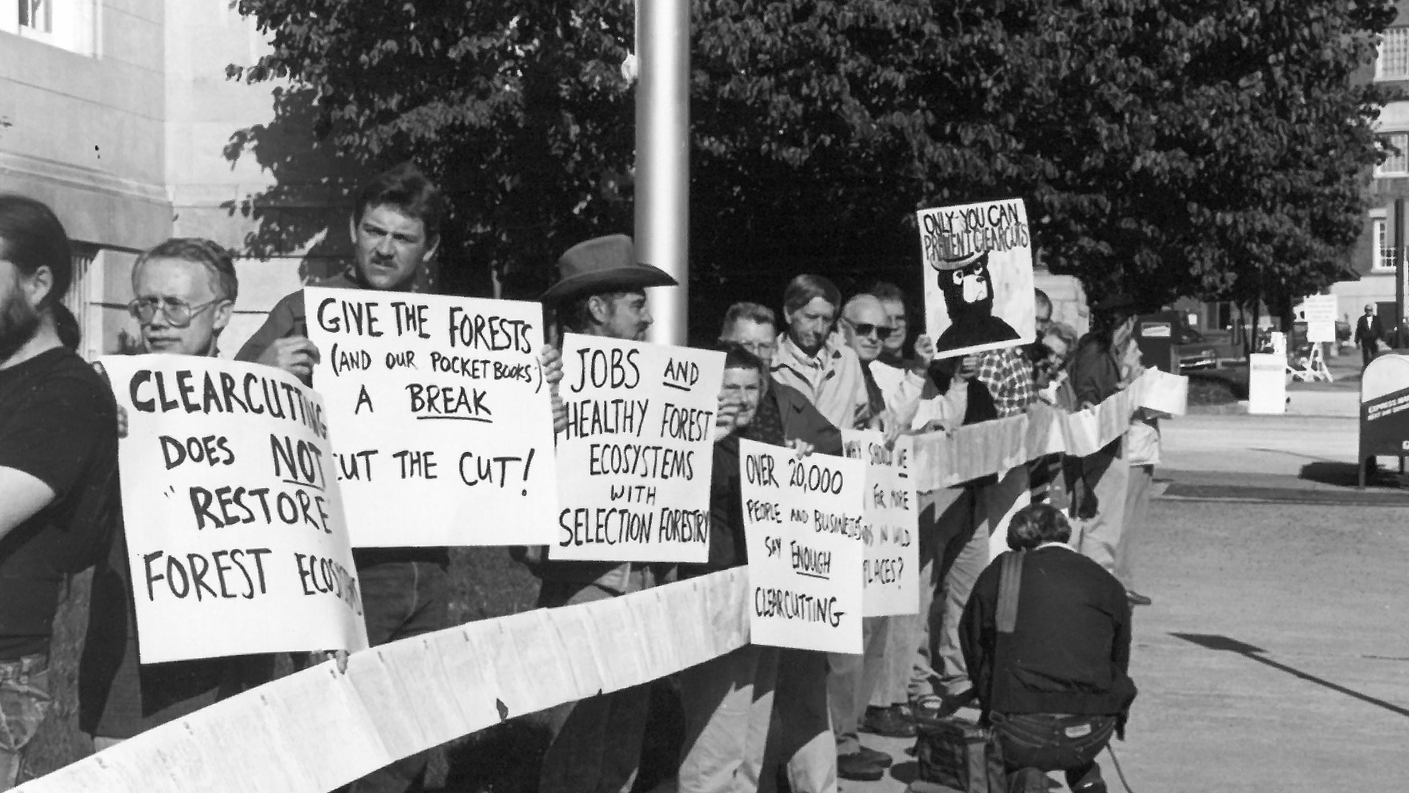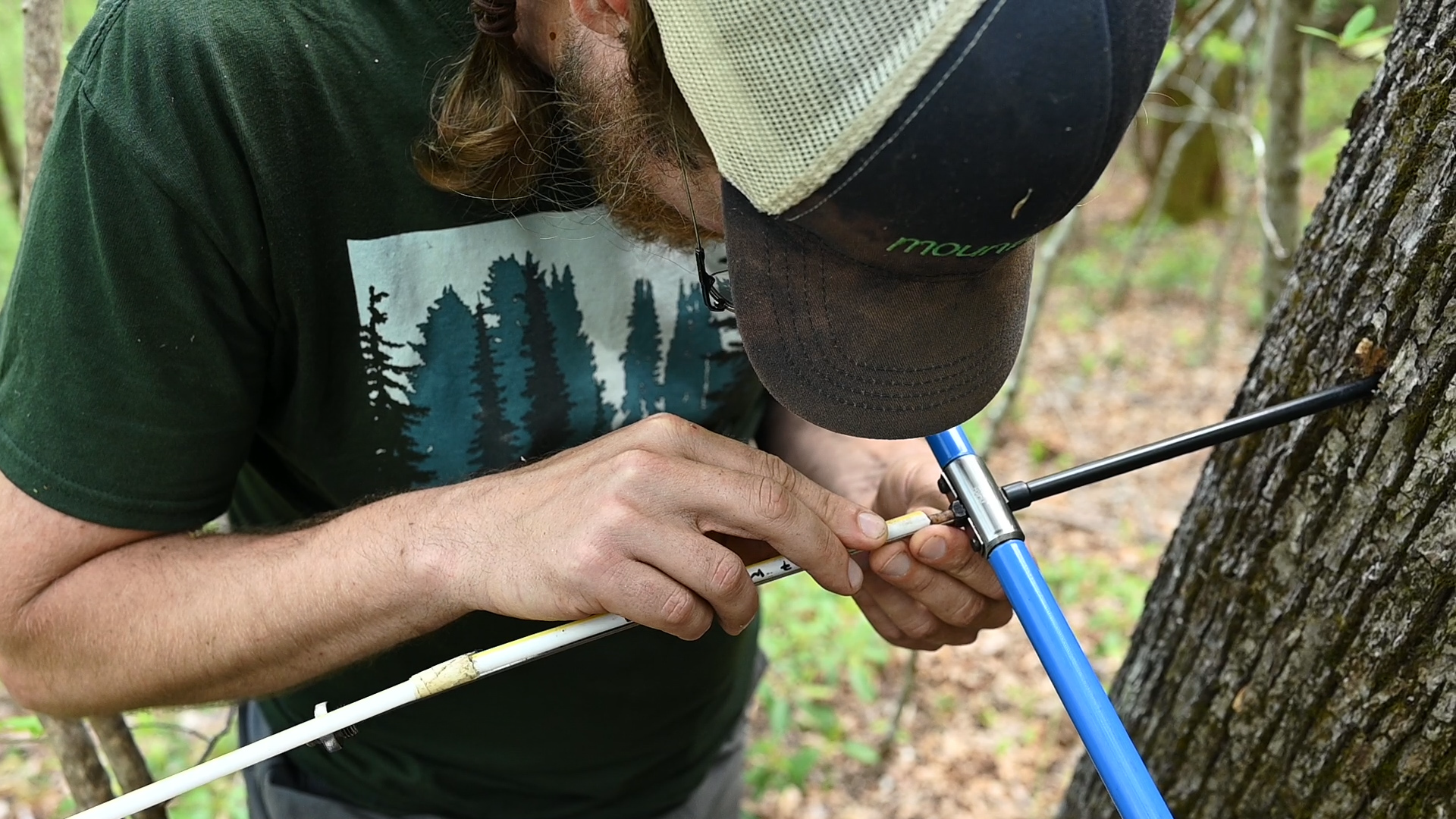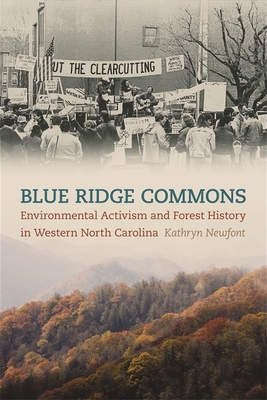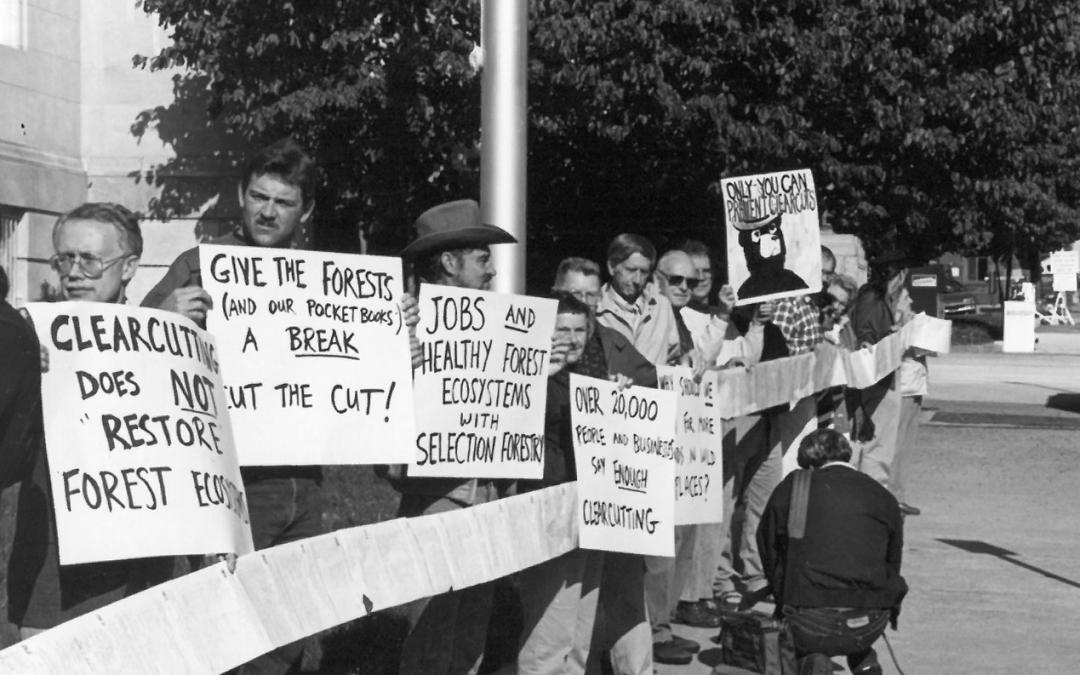Cut the Clearcutting

Pictured above: WNCA members collected more than 15,000 petition signatures to stop the practice of clearcutting in Nantahala and Pisgah National Forests. When all the petition pages were taped together, they were the length of three football fields.
By Bob Gale, MountainTrue Ecologist and Public Lands Director
In 1976, Congress passed the National Forest Management Act (NFMA) requiring the U.S. Forest Service to produce management plans for all national forests. The combined force of the NFMA and the Multiple Use Sustained Yield Act of 1960 required the agency to adopt a multi-focus management approach that equally prioritized timber production, water, wildlife, and recreation in our national forests.
Issued in 1987, the first Nantahala-Pisgah Management Plan was considered by many to simply be a 50-year blueprint for logging. Prior to the oil and gas drilling threat, the Forest Service had been ramping up timber sales in national forests around the U.S. The logging was occurring at an unstainable rate and it was employing the most damaging method of logging — clearcutting. This clearcutting was causing extensive damage to Western North Carolina’s (WNC) forest ecosystems. From erosion on mountain slopes to the severe sedimentation of streams and rivers, as well as the negative impacts on native plant and wildlife communities, this clearcutting harmfully manipulated and altered thriving forest stands throughout Nantahala and Pisgah National Forests. Clearcutting also allowed for the Forest Service’s repeated entry into the stands to thin the resulting overcrowded and unhealthy trees with more cutting and/or herbicides.
The rampant and highly visible clearcutting that was taking place all over the WNC mountains angered the public. The passion and organizing capacity of WNC Alliance (WNCA) members channeled the wider public’s outcry into an effective, people-powered grassroots campaign, which gained the Forest Service’s attention and ultimately brought an end to clearcutting.
WNCA founders Esther Cunningham and David Liden enlisted the help of the organization’s Forest Management Task Force (FMTF) to address the clearcutting issue. The FMTF was comprised of an elite group of forest-savvy members from all over WNC and it received major credibility and inspiration from Walton Smith, a retired and well-respected Forest Service silviculturist. Smith and another retired forester and FMTF member, Bob Padgett, strongly believed that clearcutting — or even-aged management, as it was euphemistically known in the profession — was damaging mountain forest ecosystems. They also believed that more sustainable timber harvesting methods existed. Smith, Padgett, and another clearcutting critic and WNCA supporter, Clemson Emeritus Forestry Professor Bob Zahner, gave WNCA tremendous credibility on this issue. The FMTF cleverly attached the title, Cut The Clearcutting, to their crusade. FMTF members provided energy for the region-wide effort, which included local appeals, protests, letter-writing campaigns, and other activities.
Smith led WNCA members through timber sale stands to demonstrate how clearcutting was causing harm and explain how sustainable forestry should be accomplished. He re-designed the famous Biltmore Stick used to measure the potential value of a timber stand by adding other important measurements and renaming it the WalDee Stick — a combination of his own name and that of his wife, Dee. Smith taught WNCA members how to gather on-the-ground data by using the WalDee Stick, which the organization then used to document errors in Forest Service’s timber sale proposals. He also demonstrated how the agency’s removal of the diverse hardwood species in rich coves left them vulnerable to a tulip tree monoculture that suppressed oaks and other native species.

Pictured above: MountainTrue’s Public Lands Field Biologist, Josh Kelly, counts the rings on a tree in Nantahala National Forest.
As Esther, David, and early WNCA members were wrestling with this problem, a young activist named Monroe Gilmour was fighting to protect an ill-thought-out proposal to begin logging in the Asheville Watershed — the source of the pristine drinking water supply for the city and its surrounding communities. Gilmour knew the water supply would be severely impacted if the forest canopy protecting the drainage system’s soils and headwaters were cleared.
Gilmour rallied local concerned citizens and founded a group named Citizens Against Clearcutting the Asheville Watershed, with its jeering acronym “CACAW.” His campaign was successful in raising public concern and opposition to the proposal. Gilmour’s efforts ultimately led to the prohibition of logging in the watershed’s higher elevations through the creation of a conservation easement held by the city and the Conservation Trust of North Carolina.
Impressed with this success, WNCA hired Gilmour to help run its new Cut The Clearcutting campaign. He coordinated the diverse parts, including developing a schedule of events, getting the campaign covered in the media, printing petitions, and collecting signatures throughout WNC counties. A peak of the campaign occurred with a well-organized demonstration in Asheville involving a variety of knowledgeable speakers. The petitions were securely taped together by members of the Unity of the Blue Ridge Church in Henderson County and combined onto a giant roll. Another roll of petitions was compiled from businesses across the mountain counties.
The demonstration began with a downtown march consisting of hundreds of participants led by a huge “Cut The Clearcutting!” banner and ended with volunteers unrolling of the long chain of petitions in front of the Forest Service Headquarters.
Appalachian mountain music played on guitar, fiddle, and banjo by Rob and Mary Kelly and Bill West of Madison County underscored the local connection and added excitement to the event. In fact, a photo of their performance is featured on the cover of the book, Blue Ridge Commons, by Kathryn Newfont (pictured right).

The collective expertise and action by WNCA’s members got the attention of the Forest Service Supervisor and after countless meetings over several years with the agency, the agency’s management plan for Nantahala and Pisgah National Forests was significantly amended in 1994. WNCA was influential in getting clearcutting dropped as a harvesting method, establishing buffers from logging within stream corridors, and designating protected old-growth tracts within timber management areas. These protections were innovative and the Nantahala-Pisgah National Forest Management Plan became a national model.
Thanks to the hard work of WNCA founders, staff, forestry experts, and volunteers, the organization successfully went to bat (and hit a home run) for the continued wellbeing of Nantahala and Pisgah National Forests in its early years. And that work continues today as our Public Lands Team remains dedicated to the protection of these two beloved national forests through sound, science-backed management that perpetuates the unique biodiversity and honors the cultural and spiritual importance of these ancient mountain forests.

